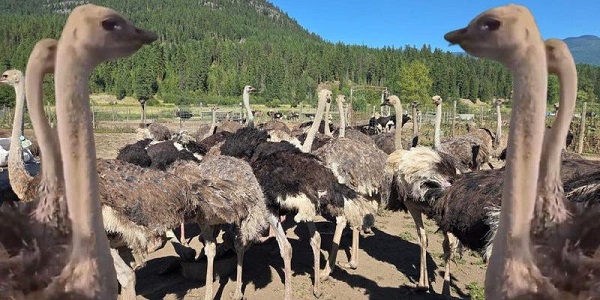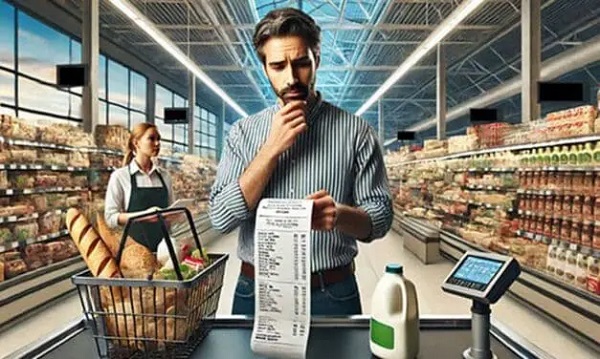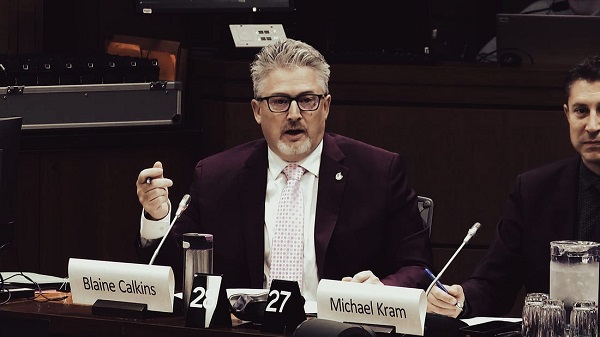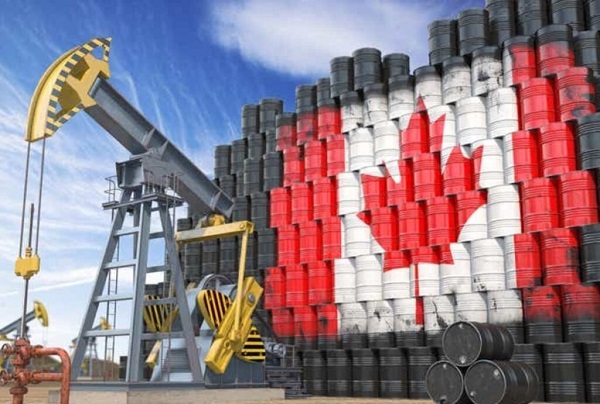Agriculture
Canadian innovation beats EU precaution in agriculture sustainability

From the MacDonald Laurier Institute
By Stuart Smyth
Canada should learn from, not follow, the EU’s agriculture policy errors
The world needs a lot of food to feed eight billion hungry mouths. Even though global production for the most important crops – rice, wheat and maize – reached all-time highs last year, inflation, geopolitical interruptions and misguided policy have disrupted our ability to make food abundant and affordable for everyone.
Crop breeding, more efficient fertilizer and chemical use, and investments in farming equipment and technology offer tried and true strategies for increasing production while enhancing sustainability and reducing GHG emissions.
The European Union is rejecting these proven strategies through policies that dramatically reduce fertilizer and chemical use and ban modern crop breeding technologies. Regrettably, Canada’s federal government is looking at the European approach as a model for its emissions reduction plans. Canadians must reject the ideologically driven, counterproductive policies pursued in the European Union and must insist on science and outcome-driven policies to promote a strong, sustainable agricultural sector that can help satisfy the world’s growing needs.
Innovation is fundamental to modern societies and economies. Governments constantly encourage innovation and enact policies to incentivize investment into the research and development required to bring new products and processes to market. In recent years, environmental sustainability has been a primary concern and Canadian agriculture has been at the forefront of sustainable innovation. Fundamentally, sustainability in agriculture means maximizing efficiency: producing more pounds of crop per acre of land for each pound of input (seed, fertilizer, pesticides, labour) applied.
Prior to the widespread adoption of modern crop technologies, all crop and food production was done through what are now known as organic production practices. With organic production the only way to produce more food is to use more land. However, beginning in 1960, food production became decoupled from increased land use, increasing by 390% while using only 10% more land. Innovations in crop breeding technologies such as GM crops (genetically modified), fertilizer and chemical use, and farm industrialization have all contributed to this increasingly sustainable food production.
This increase in productivity has allowed the world’s population to flourish from just 3 billion people in 1960 to 8 billion today. Although the global agricultural sector is a significant source of greenhouse gases, total emissions have remained flat since 2000 even as production increased, and the sector’s share of global emissions has declined.
Despite this incredible success story, modern agriculture is often viewed with suspicion, particularly in the European Union. They have incorporated precaution-based regulations which dramatically reduce fertilizer and chemical use and ban modern crop breeding technologies. Presently they are proposing to triple organic production, from 8% of current land to 25%, by 2030, as part of what’s known as their “Farm to Fork” strategy to reduce agricultural GHG emissions.
Inevitably, the strategy will not necessarily reduce emissions but will certainly reduce production. Declines are expected: -26% in cereals, -27% in oilseeds, -10% for fruits and vegetables, -14% of beef and -9% of dairy. All of these production decreases will contribute to even higher food prices in the EU, which has been experiencing double digit inflation increases for most of the past year.
By contrast, Canada allows all plant breeding technologies to be used in the development of new varieties, and fertilizer and chemical use is based upon risk appropriate, science-based regulations. The benefits of this approach are unambiguous.
In Saskatchewan, only 3% of crop land requires tillage – mechanical turning of the soil to control for weeds and pests and prepare for seeding. In the European Union, 74% of crop land requires it. Removing tillage from land management practices not only reduces soil erosion and increases moisture conservation; it also reduces the amount of carbon released and increases the sequestration of carbon through continuous crop production. 90% of Saskatchewan farmers indicate that efficient weed control provided by the use of glyphosate increased sustainability in their practices, and 73% said production of herbicide tolerant canola, which is predominantly GM, did.
An assessment of EU agricultural GHG emissions concluded that had genetically modified crops been adopted there in a timely fashion, total EU agricultural GHG emissions would have been reduced by 7.5%. This amounts to 33 million metric tonnes of carbon dioxide per year. At any rate, their reduced yields have left them heavily dependent on imports of GM livestock feed from Brazil and Argentina.
Comparing sustainable agricultural production between the EU and Canada reveals two very different situations. The EU has rejected GM crops due to politics and precaution and as a result still heavily relies on tillage. Canadian farmers have enthusiastically adopted GM crops, virtually eliminating tillage. The EU is proposing additional precaution-based regulations that will further reduce crop and food production. Canadian farmers have demonstrated the ability to produce more food with fewer inputs, while the EU is poised to produce less, with more land requirements.
Opposing paths have been selected in the EU and Canada. The evidence to date confirms that it is Canadian agricultural production that is increasingly sustainable. The government must learn the right lessons from Europe’s mistakes when adopting strategies for reducing emissions from our agricultural sector. Canada should continue to improve sustainability through innovation. Canada should not follow Europe’s failed attempts to reduce emissions by producing less food.
Stuart J. Smyth is Professor & Agri-Food Innovation & Sustainability Enhancement Chair at the University of Saskatchewan.
Agriculture
Is the CFIA a Rogue Agency or Just Taking Orders from a Rogue Federal Government?

Former Minister of Agriculture Gerry Ritz wonders who’s really in control
Canadians have been watching with increasing anger and outrage. The world has been watching with disbelief that a once great democracy could have become a petty dictatorship where the rule of law is ignored by a government agency – and hence, by the federal government itself – that believes it has impunity from the law and is above that law.
I have been writing about the disaster unfolding in Edgewood, BC for six months now. The problems began almost a year ago at Universal Ostrich Farms with an outbreak of what was believed to be avian flu. The crisis erupted when the Canadian Food Inspection Agency (CFIA) and the RCMP invaded and occupied the farm almost four weeks ago. The death squad came to kill 399 ostriches. They expected no opposition. They got plenty. Then the Supreme Court of Canada agreed to consider the farm’s appeal of a recent decision by the federal court to allow the “cull” to continue despite there being absolutely no reason for doing so. As has been noted, the CFIA steadfastly refuses to test the ostriches for avian flu.
The court ordered a stay of execution.
The CFIA has brazenly but systematically taken over this farm and is doing everything to impair the health and end the lives of the remaining birds.
It made perfect sense since the birds are healthy and have been for well over 260 days.
But the CFIA has ignored the court’s order and continued with an unofficial, piecemeal execution of the ostriches. The herd has diminished by perhaps 100 birds since the CFIA was given “custody” of the birds and the farm owners have not been allowed to feed or care for their ostriches and have instead had to trust the CFIA to do that. It was obvious from the start that these bureaucratic goons were doing anything but and in fact were cruelly mistreating the birds because, after all, they think this court order is just a temporary setback. So not only is the evidence of cruelty mounting, it is becoming obvious that the CFIA is continuing to kill the birds and remove their carcasses from the farm in dumpsters.
Former Minister of Agriculture Gerry Ritz was also an ostrich farmer at one time in his busy life. He was also minister for eight years during the administration of Prime Minister Stephen Harper and he knows how the CFIA works – and doesn’t work. He has been following the saga at Universal Ostrich Farms very closely.
“I think it’s become a debacle. The world is watching, and there’s no accountability for anything that’s being done out there. There’s a stay before the Supreme Court, but while that stay is in place, the CFIA has moved ahead with impunity to do whatever they think they’re going to need to do in the end. And I think that’s just morally and ethically wrong … They’ve gone way beyond any kind of budget capacity. They’re outspending anything I’ve ever seen them try to do,” said Ritz
“They’ve gone sideways again, and no one is calling them to task. There’s a number of people on social media. No one in the mainstream, other than, you know, “This Hour Has 22 minutes” that did a skit the other day, which I found was completely tasteless and offside. Well, that’s what they do, but at the end of the day this is a science-based organization, and I don’t see any science here. They have an opportunity to test the birds, and they refuse to do that.”
“I think it’s become a debacle. The world is watching, and there’s no accountability for anything that’s being done out there,” said Gerry Ritz
The video evidence of the neglect, maltreatment and cruelty is abundant. The CFIA has not only banned the family farm of Dave Bilinksy, Karen Espersen and her daughter Katie Pasitney from feeding the ostriches, these thugs are reluctant to do that task for them and the birds are clearly not just hungry but starving. The CFIA should have been charged weeks ago for violating basic animal cruelty laws. They should also be held accountable for treating an order from the Supreme Court of Canada with the same seriousness as an order at a fastfood restaurant.
The CFIA has even occupied an adjacent farm simply because they wanted to build a road that would allow them to bypass the protesters on the farm and continue to do their work in secret. They have established an execution pen of hay bales inside a fenced-off area of the farm that the farm owners cannot enter. Katie and her family have lost control of their livestock, their farm and their livelihood. The CFIA is conducting its clandestine and dirty work with complete impunity. No one has been charged with cruelty, they operate above the law and control the scope of work performed by the police.
So, while the farm waits to discover the decision of the Supreme Court, time is potentially running out for the ostriches. When we learned that the court would not be responding for at least two weeks after Thanksgiving, it seemed like a good omen. Two weeks to continue to consolidate public opinion against the slaughter. Two weeks to demonstrate that this form of government overreach was not just directed at one farm or one herd of ostriches but against all farmers, all property owners, anyone who has a dog or a cat at home. The CFIA has brazenly but systematically taken over this farm and is doing everything to impair the health and end the lives of the remaining birds.
There may not be a single ostrich left by the time the Supreme Court decides whether to hear the case or not. It may be a moot point and a decision without any purpose because the CFIA might have already disposed of all the ostriches, without any fear of legal consequences.
This story would be sufficiently tragic if it were only about the invasion and occupation of a family farm and the completely irrational and unnecessary decision to kill almost 400 ostriches. But it is about much more than that. It is about the Liberal government of Prime Minister Mark Carney having no respect for private property or the livelihood of farmers.
Ritz says it’s a toss-up between whether the CFIA has become a rogue agency or an agency following the orders of rogue federal government. “ think a little bit of both. Human nature tends to let you run wild if no one’s looking over your shoulder.”
“I cannot, for the like me, understand why SPCA aren’t screaming, you know, a lot more pushback than we’re seeing. Certainly they’re continuing to move ahead full steam, even while the Supreme Court decides whether they have this. [They’ve] decided to hear it, I understand, but at the end of the day, there’ll be nothing left to hear by the time they get there.”
This story would be sufficiently tragic if it were only about the invasion and occupation of a family farm and the completely irrational and unnecessary decision to kill almost 400 ostriches. But it is about much more than that. It is about the Liberal government of Prime Minister Mark Carney having no respect for private property or the livelihood of farmers. It is about a sanguinary government agency that has virtually nothing to do with public health but everything to do with killing animals. It is about the absolute refusal to the CFIA to test the birds for avian flu because the CFIA does not want to be caught in a lie or admit that herd immunity is far more effective than the vaccines that big pharma wants to sell and the Liberal government is clearly benefitting from.
This story is about your family farm, your house and backyard being occupied by the government with a trumped-up “warrant to search.” It is about your farmyard animals or your dog and cat being seized and killed by the CFIA because they say it is necessary. It is about a ravenous federal government not just “stamping out” healthy ostriches but stamping out basic liberties in Canada.
Combined with the Carney government’s obsession to censor social media, confiscate a myriad of firearms from law-abiding gun owners who are largely farmers and establish a digital ID, the tragedy at the ostrich farm is about how a country that used to respect the rule of law and democratic protocol has slid into authoritarian rule that far too few Canadians tried to stop. We know the Carney government is heavily invested in avain flu vaccines that were purchased from the UK’s GSK. Is Mark Carney personally invested?
Sources: https://x.com/TIME/status/
Does Ritz think this is all about doing the bidding of big pharma?
“Well, I’m not a conspiracy theorist, but I mean, when the chips start to fall on one side of the table, you really have to be conscious of where they’re piling up. And in this case, there’s a lot of unanswered questions. I just don’t understand how this has gotten as far as it has without some of those things being addressed,” he said asking, “Why are they refusing to test these birds?”
He noted that the cost of testing was about $100,000 when there were 399 birds still alive. “Now there are fewer. Why that would be an impediment when they’re probably spending that per day with everything they’re doing? Would that not be the ‘Get Out of Jail Free’ card for the CFIA and the RCMP to back away and say, ‘Hey, we’ve tested them. Now everything’s fine. We’re good,’” Ritz continued.
“So why they won’t test baffles the crap out of me, and that’s where, as minister, Heath MacDonald should step in and say, ‘Just get it done.’ It takes a few minutes per bird. They’ve already got the system to line them up and run them through. So why aren’t they doing that? I just can’t believe that they’re passing up this opportunity to build the science unless there’s someone calling the shots behind them who doesn’t want the science revealed.”
Agriculture
“We Made it”: Healthy Ostriches Still Alive in Canada

Looks like we made it. For another weekend at least. Until sanity settles down into the head into the head of the federal government that remains fixated on the killing of 399 healthy ostriches. As the clock wound down today, an announcement from the farm proclaimed, “We made it today,” calling it another “miracle Friday.”
WATCH TODAY’S Miracle Friday Announcement
Earlier in the day, Rebel News’ Drea Humphrey reported, “There’s apparently a SWAT team up the road, I hope that doesn’t mean they’ve gotten bad news,” wondering “if the police were preparing to aid the CFIA in the cull.”
Dacey Media reported that the farm said that “Ostrich Hunters” were also spotted at Universal Ostrich Farms according to Katie Pasitney The “kill pen” is fully set up and CFIA have been luring ostriches into it.
But as of 5:30 ET, it seems the farm and the ostriches may have escaped to live another day as the Supreme Court of Canada (SCC) did not hand down a decision to grant a further leave to the farm to prepare its case, or dismiss the case, allowing the Canadian Food Inspection Agency (CFIA) to proceed with their “cull” to kill 399 healthy ostriches.
The palpable, raw government over-reach that includes over 100 Royal Canadian Mounted Police (RCMP) that have occupied the farm highlights the mismanagement of the CFIA and may be one of the reasons that the SCC has hesitated in making a decision before the weekend.
Call to Dismantle the CFIA
On today’s Stand on Guard interview Katie Pastiney, spokeswoman for the Universal Ostrich Farms in British Columbia called for the dismantlement of the Canadian Food Inspection Agency. She says that the CFIA:
“Needs to be dismantled and we need to rebuild this organization back up from the ground up and we need to have a new vision.
“We need to have a new mission and a brand-new face for Canadians that will give us hope that we will be protected not attacked.”
“The Canadian Food Inspection Agency continues to overuse their authority, overuse their excessive freedom that they’ve been given, and they have zero accountability for their actions.”
The farm has been embroiled in a dispute with the federal government and its CFIA agency for close to a year. The agency claims the flock of ostriches has the avian flu, but it refuses to test the farmers’ birds, even though they have been healthy for 258 days. At the same time the CFIA will not let the farmers pay for the tests themselves, saying they will charge them $250,000 per ostrich and put them in jail for 6 months.
The federal agency and the RCMP have seized and occupied the farm since September 22, 2025. they have conducted a campaign of harassment of the farm family and their flock of ostriches that included: arresting the farmers when they were told to go feed their birds; using lights and heavy equipment at night’; sending drones to chase the birds that resulted in pushing one bird over the fence so it hurt its leg, not treating the animals properly; and not feeding the ostriches full rations of food and water and not treating the birds the CFIA injured. These activities have continued as the CFIA continues to construct a “kill box” of hay bales that have been on fire four times while under the CFIA’s supervision and occupation.
Running Out of Time
In a stunning report on X October 2nd, however, before the Supreme Court of Canada had made decision, the CFIA has daily continued to move forward to kill the ostriches ignoring the SCC legal “stay.”
Karen Esperson, Pasitney’s mother yesterday reported on X:
“We need to put CFIA in check.
“This organization feels they are greater than the Supreme Court of Canada. they are still positioning the birds and putting them in the position to be killed immediately. They are assuming they know the outcome of the Supreme Court oof Canada. Do they think they are better than the Supreme court? That they are going to for sure win?
“The Supreme Court has not decided.
“What is happening?
“We are on a stay order and yet I just got a call that they have a whole bunch of birds herded in a little circle in the kill pen.
“Waiting. This is animal cruelty.”
Efforts to Save the Ostriches
More and more Members of Parliament have been speaking up on behalf of the farmers including the local provincial representative, the local Member of Parliament Scott Anderson, who visited the farm trying to talk to the CFIA and also the Official Leader of the Opposition Pierre Poilievre spek out yesterday.
A second press conference hosted by John Catsimatidis, a New York radio host, billionaire and friend of Donald Trump and Dr. Oz, was also held yesterday. The USA Trump administration representatives including Robert F. Kennedy say they want to either pay for the ostrich testing or help re-locate them to the United States for further research opportunities. This outreach has been ignored.
CFIA Has Staff Enough to Kill but NOT Enough Staff to Test?
In my interview today with Pastiney she explained how the CFIA did originally give their ostrich farm an exemption that was later rescinded because the CFIA told them they were “understaffed and we’re not able to perform these tests.”
“There was an exemption package that was given to us on January 2nd. We have an email from Canadian Food Inspection Agency stating that we qualify for special rare genetics within our herd and that we could be exempt.
“Now when we followed through with that because we needed to test them just to show their DNA and their genetics and show their lineage that between January 2nd and January 10th something happened.
“Now we didn’t qualify we lost that right.
“And on January 10th they said sorry you don’t qualify for special rare genetics because we are understaffed and we’re not able to perform these tests.”
Why does the CFIA have staff to occupy the farm for weeks and to kill 399 ostriches as well as requisition the Royal Canadian Mounted Police (RCMP) over 40 cars and reportedly more than 100 police on the farm since September 22nd, and not have the money to test the birds for the exemption?
How much has this debacle and exercise into Carney Government overreach been charged to Canadian taxpayers?
More than the tests to see if the ostriches are healthy or if they qualify for the exemption?
Other Farmers May Join in Efforts to Disband the CFIA
Pastiney says:
“I just did an interview with a farmer that this very same thing happened to them and it was based off a suspicion of tuberculosis outbreak on their farm.
“They [the farmers] had over 600 head of cattle, they had sheep, they had goats, they had pig or pigs, they had chickens.
“They [the CFIA] came in based off suspicion and off their own negligence they killed everything this beautiful older farm had to find out in the end that they tested after everything was dead and there was no tuberculosis.”
“I asked her a very important question, and I said could you trust this organization again? And she said, absolutely not.
“So, it became very clear to me after this about talking to two or three farmers that the Canadian Food Inspection Agency needs to be dismantled.”
“It is an organization that has lost the trust of Canadians.
CONCLUSION
WATCH Katie is Fighting For Everyone’s Freedom | Stand on Guard
www.kraydensrightnews.com is a reader-supported publication.
To receive new posts and support my work, consider becoming a free or paid subscriber.
-

 Alberta1 day ago
Alberta1 day agoPremier Smith sending teachers back to school and setting up classroom complexity task force
-

 Business2 days ago
Business2 days agoThe painful return of food inflation exposes Canada’s trade failures
-

 Alberta2 days ago
Alberta2 days agoCoutts border officers seize 77 KG of cocaine in commercial truck entering Canada – Street value of $7 Million
-

 International21 hours ago
International21 hours agoBiden’s Autopen Orders declared “null and void”
-

 Business23 hours ago
Business23 hours agoTrans Mountain executive says it’s time to fix the system, expand access, and think like a nation builder
-

 National2 days ago
National2 days agoElection Officials Warn MPs: Canada’s Ballot System Is Being Exploited
-

 Business2 days ago
Business2 days agoOttawa Bought Jobs That Disappeared: Paying for Trudeau’s EV Gamble
-

 Canada Free Press21 hours ago
Canada Free Press21 hours agoThe real genocide is not taking place in Gaza, but in Nigeria























